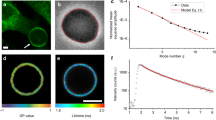Abstract
The differences in the surface active properties of native lipids extracted from plasma membranes of cells cultured as a monolayer and in three-dimensional (3D) matrix were investigated. This experimental model was chosen because most of the current knowledge on cellular physiological processes is based on studies performed with conventional monolayer two-dimensional (2D) cell cultures, where cells are forced to adjust to unnaturally rigid surfaces that differ significantly from the natural matrix surrounding cells in living organisms. Differences between monolayer and 3D cells were observed in the lipid composition of plasma membranes and especially in the level of the two major microdomain-forming lipids—sphingomyelin (SM) and cholesterol, which were significantly elevated in 3D cells. The obtained results showed that culturing of cells in in vivo-like environment affected the surface active properties of plasma membrane lipids at interfaces which might influence certain membrane-associated interface processes. The detected differences in the lipid levels in 2D and 3D cell extracts affected significantly the behavior of the model lipid monolayers at the air–water interface (Langmuir monolayers) which resulted in different values of the monolayer equilibrium (γeq) and dynamic (γmax, γmin) surface tension and surface potential. Compensation of the SM content in extracts of 2D cell cultures up to a level close to the one measured in 3D cells approximated the monolayer properties to the values observed for 3D cells. These results implied that the interactions between the cells and the surrounding medium affected the level of plasma membrane SM and other lipids, which had a strong impact on the surface properties of lipid monolayers, such as γeq, γmax, and γmin, the compression/decompression curve shape, the hysteresis area during cycling of the monolayers, etc. We suggest that the elevated content of SM observed in plasma membranes of 3D fibroblasts could be responsible for an increased rigidity and possibly reduced permeability of cells cultured in 3D environment. The current results provide useful information that should be taken into account in the interpretation of the membrane physico-chemical properties of cells cultured under different conditions.




Similar content being viewed by others
References
Lalchev, Z. (1997). Surface properties of lipids and proteins at bio-interfaces. In K. S. Birdi (Ed.), Handbook of surface and colloid chemistry (pp. 625–687). Boca Raton, New York, London, Tokyo: CRC Press.
Lalchev, Z., Todorov, R., & Exerowa, D. (2008). Thin liquid films as a model to study surfactant layers on the alveolar surface. Current Opinion in Colloid and Interface Science, 13, 183–193.
Dimitrov, O., & Lalchev, Z. (1998). Interaction of sex hormones and cholesterol with monolayers of DPPC in different phase state. Journal of Steroid Biochemistry and Molecular Biology, 66, 55–61.
Lalchev, Z., Valtcheva, R., Mitev, V., & Stephanova, E. (2004). Tensiometric study of surface activity and halothane impact on biosurfactant production of lung cells. Colloids and Surfaces A: Physicochemical and Engineering Aspects, 250, 527–531.
Edelman, D., & Keefer, E. (2005). A cultural renaissance: In vitro cell biology embraces three-dimensional context. Experimental Neurology, 192, 1–6.
Grinnell, F. (2003). Fibroblast biology in three-dimensional collagen matrices. Trends in Cell Biology, 13, 264–269.
Ishikawa, O., Kondo, A., Okada, K., Miyachi, Y., & Furumura, M. (1997). Morphological and biochemical analyses on fibroblasts and selfproduced collagens in a novel three-dimensional culture. British Journal of Dermatology, 136, 6–11.
Cukierman, E., Pankov, R., Stevens, D., & Yamada, K. (2001). Taking cell-matrix adhesions to the third dimension. Science, 294, 1707–1712.
Cukierman, E., Pankov, R., & Yamada, K. (2002). Cell interactions with three-dimensional matrices. Current Opinion in Cell Biology, 14, 633–639.
Ahlfors, J.-E. W., & Billiard, C. L. (2007). Biomechanical and biochemical characteristics of a human fibroblast-produced and remodeled matrix. Biomaterials, 28, 21–83.
Pankov, R., Markovska, T., Antonov, P., Ivanova, L., & Momchilova, A. (2005). Cholesterol distribution in plasma membranes of β1 integrin expressing and β1 integrin deficient fibroblasts. Archives of Biochemistry and Biophysics, 442, 160–168.
Bligh, E., & Dyer, W. (1959). A rapid method of total lipid extraction and purification. Canadian Journal of Biochemistry and Physiology, 37, 911–917.
Touchstone, J., Chen, J., & Beaver, K. (1980). Improved separation of phospholipids by thin layer chromatography. Lipids, 15, 61–62.
Kahovcova, J., & Odavic, R. (1969). A simple method for the quantitative analysis of phospholipids separated by thin layer chromatography. Journal of Chromatography, 40, 90–96.
Shinitzky, M., & Barenholtz, Y. (1974). Dynamics of the hydrocarbon layer in liposomes of lecithin and sphingomyelin containing diacetylphosphate. Biochemistry, 249, 2652–2657.
Van Blitterswijk, M., Van Hoeven, R., & Van Der Meer, B. (1981). Lipid structure order parameter (reciprocal of fluidity) in biomembranes derived from steady-state fluorescence polarization measurement. Biochimica et Biophysica Acta, 664, 323–332.
Petrov, P., Thompson, J., Rahman, I., Ellis, R., Green, E., Miano, F., et al. (2007). Two-dimensional order in mammalian pre-ocular tear film. Experimental Eye Research, 84, 1140–1146.
McIntosh, T. (1978). The effect of cholesterol on the structure of phosphatidylcholine bilayers. Biochem Biophis Acta, 513, 43–58.
Edholm, O., & Nyberg, A. (1992). Cholesterol in model membranes. A molecular dynamics simulation. Biophysical Journal, 63, 1081–1089.
Preetha, A., Banerjee, R., & Huilgol, N. (2005). Surface activity, lipid profiles and their implications in cervical cancer. Journal of Cancer Research and Therapeutics, 1, 180–186.
Acknowledgment
This work was partially supported by the Bulgarian Fund for Scientific Research (Grants DO02-212/08, BУ-Б-1/05, and DO02-107/08).
Author information
Authors and Affiliations
Corresponding author
Rights and permissions
About this article
Cite this article
Jordanova, A., Stefanova, N., Staneva, G. et al. Surface Properties and Behavior of Lipid Extracts from Plasma Membranes of Cells Cultured as Monolayer and in Tissue-Like Conditions. Cell Biochem Biophys 54, 47–55 (2009). https://doi.org/10.1007/s12013-009-9050-y
Received:
Accepted:
Published:
Issue Date:
DOI: https://doi.org/10.1007/s12013-009-9050-y




